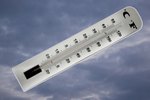Things You'll Need
Tank
Heater
Water testing kit
Plants
Tropical fish flakes
Water siphon
Glass scraper
Net
Platys come in myriad colors and patterns and all require similar care. Red wag platys might look better with different colored plants in the tank, or with a background pasted on the back of the tank, but overall the specifics of their needs are roughly the same as other platys. You can even keep differently colored platys in the same tank for a little variation. However, red wag platys are one of the most striking and beautiful of their breed.
Tank Setup
Choose your tank. It should be a minimum of 5 gallons. Platys get extremely hyper when they're healthy and the temperature is warm, so they need plenty of space to move around. The more platys you have, the more room you'll need in your tank. Up to three can live happily in a 5-gallon tank, and 20-gallon tank could hold up to 10 platys.
Set the tank's heater to somewhere between 65 and 72 degrees Fahrenheit. The higher the temperature, the higher the metabolism of the fish; as their metabolism increases, you'll need to pay close attention to their needs as they'll require more feeding and more room to zip around the tank. If you like active fish then you should keep the temperature closer to 72 degrees Fahrenheit, whereas if you prefer calm fish, keep the temperature a bit lower.
Plant live or plastic plants. The plants should be low level and close to the gravel. Platys need space, but they also like to hide occasionally. Furthermore, if you intend to breed your fish -- or do so accidentally -- the fry will need a place to hide from their cannibalistic parents.
Block out some of the light by unscrewing one of the bulbs in your tank's lid. The lighting in the platy tank should be medium bright. Platys are tropical fish, so they're used to light that has already been partially filtered and blocked by overhead branches and leaves.
Check the pH and water hardness in your tank. The pH should be 7 or 8 and the water hardness, or dH, should be 10 to 25 degrees Fahrenheit. Test the water once a week to be it stays in the proper range for pH and water hardness. Talk to a fish store associate about the results the first few times to be sure you understand them and to learn how treat your water if there are any problems.
Daily Care
Feed your platys tropical flakes at least twice a day in moderation. The higher the temperature in the tank, the more often you'll need to feed the fish to accommodate their increased metabolism. Watch them at feeding times and keep track of how much they eat. Do not feed them more than they can eat in two minutes.
Clean the tank once a week to eliminate algae growth, extra food and any diseases that might have opportunistically moved into the tank. Use a suction tube and a glass scraper, as well as water treatment liquids that help prohibit bacteria and algae.
Remove sick or dead platys from the tank immediately. Platys are a hardy breed and thus are less prone to diseases than other fish, but they are still at risk.
References
Photo Credits
-
Thinkstock/Comstock/Getty Images
Writer Bio
Jacqueline Jull began writing in 1990 and has been writing fiction and editorial articles ever since. Her work has been published in places like the "San Juan Island News Paper," the "Islander" and other sources. She has also edited for several magazines such as "New Worlds Fiction." Jull is an undergraduate university student in North Carolina studying several subjects including English.





